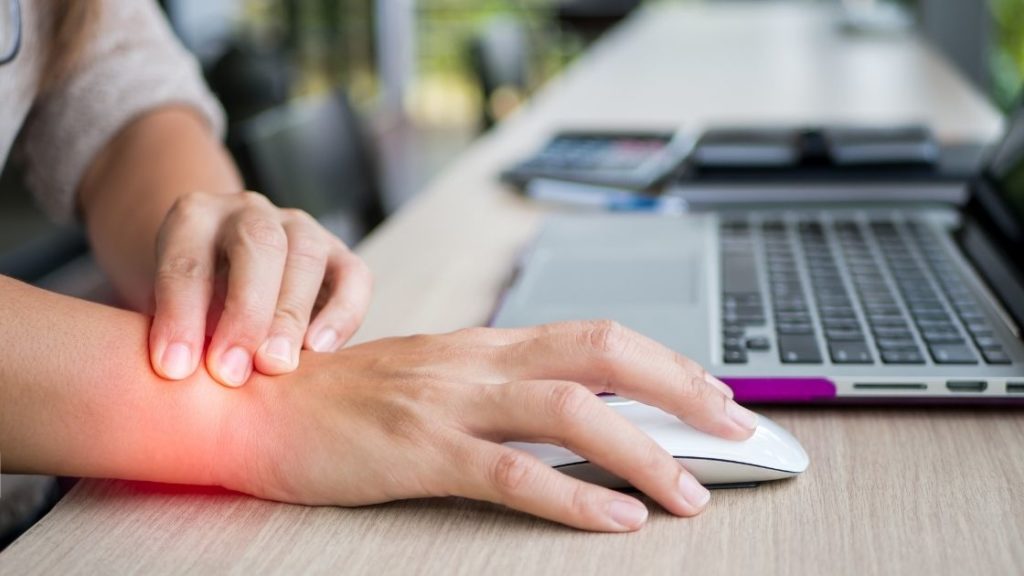Wrist Pain: What It Could Be and How to Treat It

It can range from mild to severe, presenting itself through chronic aching or sporadic jolts of pain. Regardless of how it’s experienced, wrist pain is as common as it is uncomfortable.
What can you make of pain in the wrist and surrounding areas? What could it be, and how is it caused? Most importantly, what can be done to treat the symptoms?
The Causes of Wrist Pain
Wrist pain may be a sign of an underlying disease or condition, but is often the result of wrist joint overuse during activities of daily living. Common causes of wrist pain include:
Arthritis
- Rheumatoid Arthritis – An autoimmune inflammatory disorder that causes swelling, stiffness, and impaired mobility in the joints. Over time, it can eventually cause bone erosion and bone deformity.
- Osteoarthritis – The most common type of arthritis, also known as degenerative joint disease or “wear and tear arthritis”. It occurs when the cartilage at the ends of bones begins to wear down.
- Psoriatic Arthritis – A type of arthritis that affects people with the chronic skin and nail disease, psoriasis. The symptoms are similar to those of rheumatoid arthritis, but it tends to affect the distal joints near the start of the fingernail, whereas rheumatoid arthritis usually presents itself at the joints connecting the fingers to the hands.
Carpal Tunnel Syndrome
Numbness, tingling, and weakness resulting from pressure on the median nerve. The median nerve is a sensory and motor nerve that helps you move your wrist, hands, and fingers.
Tendonitis
Inflammation of the tissue that connects bone to muscle.
Bursitis
Inflammation of the bursa, which is the fluid-filled sac that acts as a cushion for the joints.
Repetitive strain injury
- Work related tasks that overuse or overexert the fingers, hands, and wrists put one at highest risk.
-
-
- Clicking a mouse, typing, lifting, driving, kneading, scanning groceries, bagging, etc.
-
- Sports such as tennis, golf, and skiing can put repetitive strain on the wrists.
Disuse
Prolonged lack of movement in any body part can shorten and weaken its muscular tissue, putting the area at greater risk for injury.
Trauma
Resulting in sprains or fractures, direct impact injuries to the wrist are commonly caused by sports, motor accidents, and falls.
The Importance of Wrist Health
Taking charge of your wrist health will ease the pain of pre-existing wrist conditions and slow the progression. Healthy circulation delivered through massage can improve mobility in stiff joints, as well as reduce pain and swelling.
It’s also important to note that a seemingly non-serious wrist injury can worsen and become a long-term problem. Conditions such as tendonitis and bursitis can heal on their own with non-invasive treatment, but if left ignored may end up requiring surgery. Untreated repetitive strains increase the risk of wrist-related diseases such as arthritis.
Serious cases of wrist pain can significantly impact everyday life. Menial tasks, such as opening a jar or buttoning a shirt, can become difficult or undoable. A severe wrist condition can also inhibit one’s ability to perform work related tasks. The damage may eventually lead to a person losing their sense of independence, requiring assistance with everyday activities.
Our Four Step Approach for Treating Wrist Pain
Our evidence based treatment to all types of musculoskeletal pain are as follows:
- Remove knots from affected muscles
- Lengthen the constricted muscular tissue
- Mobilize impacted joints
- Strengthen weakened muscles
Modalities for Wrist Pain Treatment
The following bodywork techniques can relieve wrist pain and slow the progression of wrist-related condition/diseases:
- Deep tissue massage to remove muscular adhesions
- Pin and Stretch Techniques to lengthen tight muscular tissue
- Joint range of motion exercises to mobilize wrist joints
- PNF stretches to strengthen hand and wrist muscles
In addition to the above-mentioned techniques best for executing the goals of our Four Step Approach, Swedish massage and lymphatic drainage massage are also ideal modalities for wrist pain treatment. Both types of massage promote healthy circulation, which nourishes damaged tissue to speed up the recovery process. In addition to improved blood flow, Swedish massage relaxes the body and relieves stress, which signals the brain to release pain-reducing chemicals. Lymphatic drainage, which removes toxins by guiding waste products into the lymph nodes, is ideal for reducing swelling and stiffness brought on by wrist-related medical conditions.
Now You Know!
Schedule a massage with one of our talented massage therapists today! But before you do, ask your physician which modalities will be safest and most effective for your unique needs.

Katrina Jenkins
Author, Licensed Massage Therapist
Katrina Jenkins graduated from Towson University in 2013 with a Bachelor’s Degree in Health Science and worked as a nurse’s aide briefly before pursuing her true passion. She graduated from the Massage Therapy Institute of Colorado in April 2016 with honors and completed the Touch of Healers Scholarship Program the following summer. She has been a part of the Moyer Total Wellness Team since the summer of 2017.
Resources
Colino, S. (2021). Psoriatic Arthritis vs Rheumatoid Arthritis. [online] EverydayHealth.com. Available at: https://www.everydayhealth.com/psoriatic-arthritis/living-with/how-you-know-its-psoriatic-arthritis/.
Ferguson, R., Riley, N.D., Wijendra, A., Thurley, N., Carr, A.J. and BJF, D. (2019). Wrist pain: a systematic review of prevalence and risk factors– what is the role of occupation and activity? BMC Musculoskeletal Disorders, 20(1).
https://www.facebook.com/WebMD (2003). Carpal Tunnel Syndrome. [online] WebMD. Available at: https://www.webmd.com/pain-management/carpal-tunnel/carpal-tunnel-syndrome.
May Jr, D.D. and Varacallo, M. (2020). Wrist Sprain. [online] PubMed. Available at: https://www.ncbi.nlm.nih.gov/books/NBK551514/.
Photo Credit
Canva by spukkato
